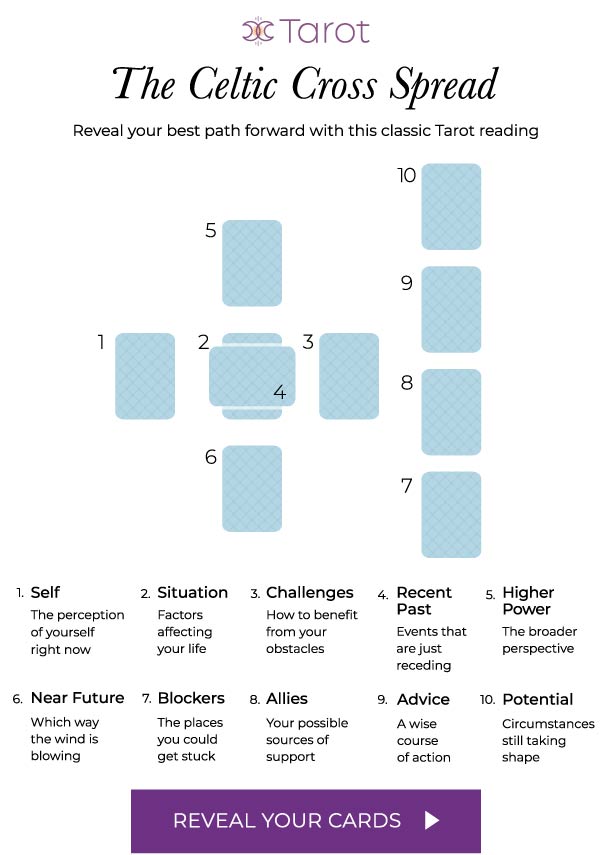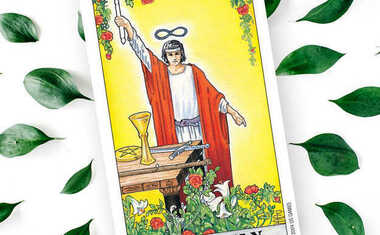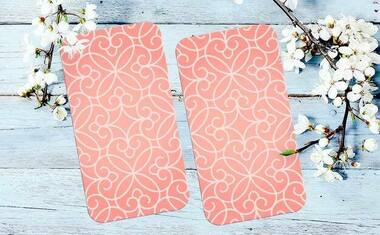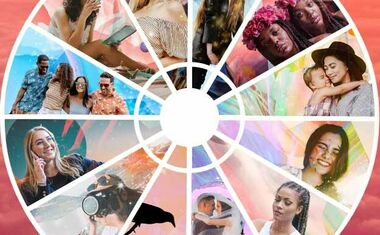
Glossary of Tarot Terms
Brush up on your Tarot vocabulary!
Tarot
Tarot is a divination system that uses a specific set of 78 illustrated cards. Some people see Tarot as a way to peer into the future or examine hidden aspects of a situation, while others use it as a therapeutic resource or simply a support for thinking outside the box and creating a sacred moment for themselves.
The first written references to Tarot decks are over 500 years old. With archetypal roots that go back almost 2,000 years, Tarot has become a repository of ancient wisdom.
Tarot Reading
A Tarot reading is an occasion to draw and interpret cards from a Tarot deck in order to examine a situation or find inner strength. From simple to complex, Tarot readings can involve any number of cards, and they can be done solo (reading cards for oneself) or collaboratively (working with another person to interpret the cards). At Tarot.com, all of our card interpretations are tailored to the themes of our readings by experienced Tarot readers.
Browse Our Online Tarot Readings
Major Arcana
The Major Arcana cards, also called trump cards, are the most recognizable cards in the Tarot deck. These cards represent significant life events and energies on a large scale.
Try our Exclusive Major Arcana Tarot Reading, Two Hearts Tarot
Minor Arcana
The Minor Arcana cards, also called pip cards, make up the majority of a Tarot deck and represent more mundane life events, day-to-day concerns, and character traits. These 56 cards are divided evenly into four suits, similar to a standard deck of playing cards.
Court Cards
Each suit within the Minor Arcana includes four Court Cards, making a total of sixteen in the entire Tarot. Traditionally called Pages, Knights, Queens, and Kings, these cards have historically been seen as representatives of actual people. Modern interpretations tend to view the Court Cards in a more symbolic way, interpreting them as sides of one’s own personality.
Try our Exclusive Court Card Tarot Reading, Hidden Truth Tarot
Suits
The Minor Arcana contains four suits, most traditionally named Wands, Cups, Swords, and Pentacles. Each suit is made up of four cards, beginning with the Ace, progressing through numbers two through ten, and concluding with the Court Cards (Page, Knight, Queen, and King).
Elements
Just as zodiac signs are commonly associated with certain elements, Minor Arcana cards carry special relationships as well. You likely know that there are fire signs (Aries, Leo, and Sagittarius), earth signs (Taurus, Virgo, and Capricorn), air signs (Gemini, Libra, and Aquarius), and water signs (Cancer, Scorpio, and Pisces). The Minor Arcana can reference the same elements.
The elemental associations for Tarot suits are well-established: the Wands cards are connected with fire, the Cups cards are connected with water, the Swords cards are connected with air, and the Pentacles cards are connected with earth. Some Tarot decks will even replace the traditional suit names with these elemental names -- for example, changing the suit of Cups to the suit of Water.
Less well-established are associations between Court Card rankings and the elements. Many Tarot practitioners connect the Knights with fire and the Kings with air, while many others reverse these associations (Kings with fire, Knights with air). It’s more common to see Pages associated with the element of earth and Queens associated with the element of water, though even here, there is some amount of disagreement.
Wands (also called Rods, Staffs, Batons, Clubs, Staves, Torches, Pipes)
The Tarot suit of Wands represents the energy of movement, creativity, passion, and ideas. This suit is associated with springtime and the element of fire.
Learn More About the Suit of Wands
Cups (also called Chalices, Goblets, Vessels, Bowls)
The Tarot suit of Cups represents emotions, intuition, and relationships. This suit is associated with summertime and the element of water.
Learn More About the Suit of Cups
Swords (also called Blades, Arrows)
The Tarot suit of Swords represents thought, intellect, communication, and logic. This suit is associated with autumn and the element of air.
Learn More About the Suit of Swords
Pentacles (also called Coins, Disks, Stones, Rings)
The Tarot suit of Pentacles represents finances, resources, physical health, and work matters. This suit is associated with winter and the element of earth.
Learn More About the Suit of Pentacles
Tarot Reader
A Tarot reader is a person who interprets Tarot cards.
Querent
A querent is a person for whom Tarot cards are being interpreted. Generally, this is a person who’s seeking wisdom or insight from the Tarot and is consulting with an experienced Tarot reader to receive a Tarot reading.
Tarot Spread
A Tarot spread is a layout of Tarot cards to be used in the context of a reading. Tarot spreads indicate the number of cards to be drawn from the deck and, in some cases, the way in which they should be arranged (in a straight line, in a circle, in a triangle, etc.). Typically, each spot in a Tarot spread comes with its own associated meaning or question.
Explore Some of Our Favorite Tarot Spreads
Celtic Cross
The Celtic Cross is a classic Tarot spread first published in the early 1900s, though its origins go back even further. This spread features ten Tarot cards laid out in a specific fashion, with two cards forming a cross in the center, four additional cards surrounding that center cross in a larger cross shape, and the final four cards creating a vertical line on the right side.

The positions in the Celtic Cross Tarot spread have assigned meanings as follows:
- Self: How you perceive yourself right now
- Situation: Social or circumstantial factors that could be affecting your life now
- Challenges: How to turn your obstacles into opportunities
- Recent past: Events that are just receding -- recently influential but now diminishing in power
- Higher power: The broader perspective and influence of your conscience
- Near future: The direction the wind is blowing in your situation
- Blockers: Any self-undermining tendencies, areas where you could be in denial, or where you could get stuck
- Allies: People who can be supportive or helpful to you now
- Advice: A course of action which will harmonize what you want with what is currently possible
- Long-term potential: Unknown circumstances that are still taking shape
Try a Celtic Cross Tarot Reading
Clarifying Card (or Clarity Card)
A clarifying card is a Tarot card drawn after the reading is complete in order to get additional information. This card can be pulled from the deck as a way to clarify one particular part of a Tarot reading or to summarize the message of the reading as a whole.
Tarot Deck
A Tarot deck is a specific deck of Tarot cards, created according to the vision of a particular artist or group of artists.
Browse Our Collection of Tarot Decks
Tarot Birth Card
A Tarot birth card is a card from the Major Arcana that has special relevance to you based on your date of birth. It reflects a central piece of your path and identifies the life lessons you most need to learn.
Most people have two Tarot birth cards, but a select few actually have three! By doing some simple math with your birthday or using our calculator, you can figure out which ones have the most important messages for you.
Discover Your Tarot Birth Cards
Reversal
Reversals are Tarot cards that come out of the deck turned upside-down. Depending on the way you shuffle a Tarot deck, reversed cards may come up regularly or infrequently. Some Tarot readers simply turn a reversal around and interpret it as usual, but more commonly, a reversal is seen as a sign that the card’s default energy or meaning is somehow skewed.
Learn More About Tarot Card Reversals
Divination
Divination is the practice of seeking knowledge about the future or the unknown through supernatural means. Tarot reading is generally considered a divinatory method, along with rune casting, I Ching reading, tea leaf reading, and other similar methods.
Contemporary approaches to Tarot also include processes that are not divinatory and focus instead on Tarot's usefulness as a therapeutic or self-care tool.
Rider-Waite Deck (also called the Rider, Waite-Rider, Rider-Waite-Smith, Smith-Rider-Waite)
The Rider-Waite Tarot deck is arguably the most widely-used and influential Tarot deck of all time. Published in 1909, the deck was named after A.E. Waite, the British poet and mystic who commissioned the deck, and William Rider & Son, the deck’s publisher.
The Rider-Waite was the first Tarot deck to feature unique illustrations for the Minor Arcana cards. Previous decks had unique illustrations for the Major Arcana, but when it came to the Minor Arcana, cards were illustrated very simply. The Three of Swords displayed three swords, for example. The Eight of Cups displayed eight cups. This innovation was the work of the deck’s illustrator, artist Pamela Colman Smith, whose involvement in the project was virtually unrecognized for decades. In recent years, it’s become more common to insert Smith’s name alongside the others when referencing the deck.
Explore Decks Based on the Rider-Waite, including the Apprentice Tarot, Gummy Bear Tarot, Melanated Classic Tarot, Modern Witch Tarot, Smith-Waite Centennial, and Universal Waite
Thoth Deck (also called the Crowley)
The Thoth Tarot deck is an influential and experimental Tarot deck published in 1943. Conceptualized by English occultist and philosopher Aleister Crowley and painted by artist Lady Frieda Harris, the Thoth deck is known for its Art Deco style and its portrayal of esoteric symbols.
Oracle Cards
Oracle cards are decks loosely based on the idea of Tarot, but with more flexibility and variability. While a Tarot deck contains a specific set of 78 cards, oracle card decks can include any number of cards with all kinds of names or messages. Nevertheless, oracle cards can be used in a similar manner and provide valuable insight and guidance.
Angel Cards
Angel cards are a specific kind of oracle cards that feature illustrations of angels or other otherworldly beings. Many people turn to angel cards for inspiration that aligns with their religious backgrounds or spiritual beliefs.
Lenormand Cards
Lenormand cards are similar to Tarot cards -- they are also used for divination, and they follow a set structure. Each Lenormand deck contains 36 cards, each with its own name and associated meaning. Readings done with Lenormand cards are typically considered more literal than those done with Tarot cards.
Looking to try Tarot reading on your own? Check out “A Beginner’s Guide to Tarot.” This digital 18-page workbook allows you to explore the Major and Minor Arcana, learn how to offer basic Tarot readings, and embrace Tarot rituals in one approachable guide. Happy reading!



